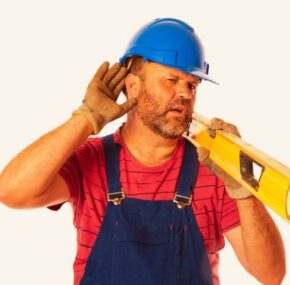Hearing loss caused by exposure to loud noise and lack of proper ear protection is the most common workplace injury in America.

Hearing Loss in the Workplace
According to the Centers for Disease Control and Prevention (CDC), hearing loss is the most common work-related injury in the United States. The CDC estimates that more than 20 million American workers experience damaging levels of noise in their workplace each day. Statistics from the U.S. Department of Labor show that $250 million in workers’ compensation benefits are paid out every year to workers who experience work-related hearing loss, inner ear damage, or chronic ear pain.
Construction workers, warehouse and industrial workers, and miners are the most likely to encounter the highest decibel levels of noise throughout the workday. Loud noises from jackhammers, drills, air compressors, heavy equipment, and power tools put workers at increased risks for hearing damage. The National Institute for Occupational Safety and Health (NIOSH) recommends that workers should not be exposed to noise levels above 85 decibels (dBA) for more than eight continuous hours.
The Occupational Safety and Health Administration (OSHA) has established regulations for safe decibel levels in the workplace. Their hearing safety standard is set at 85 decibels (dBA), but 90 decibels are required before ear protection is mandated for workers. OSHA has been criticized by certain industries and safety organizations for not providing proper ear protection to prevent hearing loss in workers. NIOSH estimates that 30 million U.S. workers are exposed to noise levels high enough to cause irreversible hearing loss every year.
The CDC estimates that 24 percent of hearing loss in America is linked to noise exposure in the workplace. Untreated hearing damage is linked to higher rates of unemployment and lower incomes. Workers who suffer hearing damage and/or hearing loss are often forced to file workers’ compensation claims or leave high-paying jobs and apply for temporary or permanent disability.
Safety advocates urge OSHA to take a closer look at hearing loss in America and establish stricter regulations and proper ear protection for workers. They contend that noise levels set at 85 dBA or 90 dBA do not take outside factors into consideration. Workers exposed to 85 dBA for an 8-hour workday are exposed to additional noise when they leave the workplace. Additional noise from traffic, sporting events, music concerts, and everyday occurrences create cumulative risks of increased hearing damage and permanent hearing loss.







